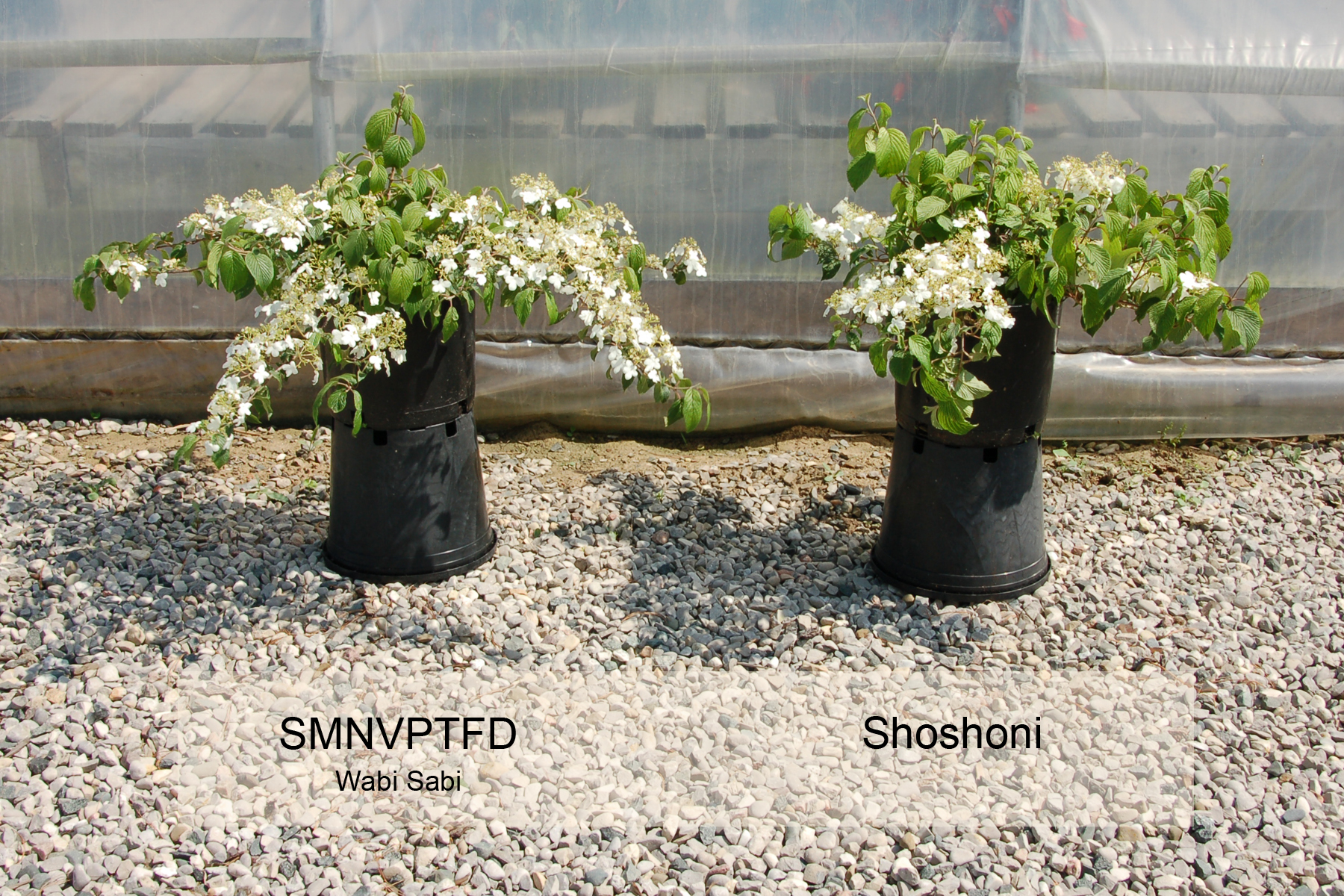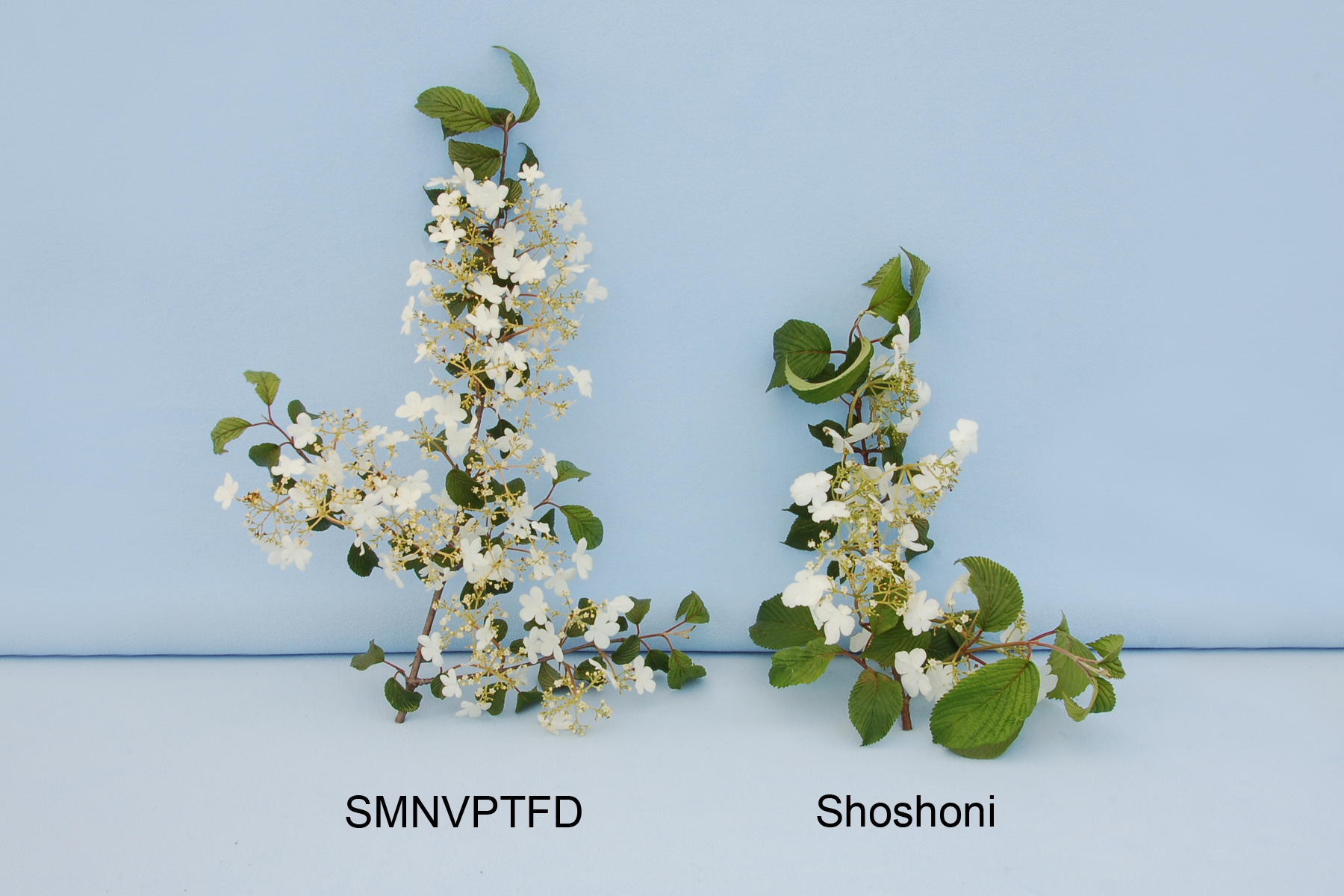SMNVPTFD
| Denomination: | 'SMNVPTFD' |
|---|---|
| Trade name: | Wabi Sabi |
| Botanical Name: | Viburnum plicatum |
| Applicant/Holder: |
Spring Meadow Nursery, Inc. 12601 120th Avenue Grand Haven, Michigan 49417 United States of America |
| Breeder: |
Timothy D. Wood, Spring Lake, United States of America |
| Agent in Canada: |
BioFlora Inc. 38723 Fingal Line R.R. #1 St. Thomas, Ontario N5P 3S5 Canada Tel: 519-317-7511 |
| Application Date: | 2017-02-06 |
| Provisional Protection:: | 2017-02-06 |
| Application Number: | 17-9094 |
| Date Withdrawn: | 2022-03-28 |
Variety Description
Variety used for comparison: 'Shoshoni'
Summary: The plants of 'SMNVPTFD' have dense branching whereas the plants of 'Shoshoni' have a medium density of branching. The leaf of 'SMNVPTFD' is smaller than the leaf of 'Shoshoni'. The upper side of the leaf blade of 'SMNVPTFD' has pubescence ranging from medium to dense whereas the upper side of the leaf blade of 'Shoshoni' has sparse pubescence. The peduncle of 'SMNVPTFD' is shorter than that of 'Shoshoni'. The peduncle of 'SMNVPTFD' has medium intensity of anthocyanin colouration whereas the peduncle of 'Shoshoni' has absent or very weak anthocyanin colouration.
Description:
PLANT: shrub to ground cover type, bushy to horizontal growth habit, dense branching, medium growth rate
STEM: grey brown, thickness ranging from medium to thick, absent or very sparse pubescence, round in cross-section, smooth texture of bark, absent or very sparse glaucosity, medium number of lenticels
SHOOT: greenish brown
LEAF: simple type, opposite arrangement along stem
LEAF BLADE: narrow ovate, acuminate apex, obtuse to weakly cordate base, serrate margin, no lobing, no variegation, medium rugosity, weak waviness of margin
LEAF BLADE (UPPER SIDE): pubescence ranging from medium to dense, medium green mid-season
LEAF BLADE (LOWER SIDE): pubescence ranging from medium to dense, light yellow mid-season, intensity of anthocyanin colouration ranging from medium to strong on veins
PETIOLE: present, intensity of anthocyanin colouration ranging from medium to strong
PEDUNCLE: medium intensity of anthocyanin colouration, medium to dense pubescence, thin
INFLORESCENCE: corymb-like type
COROLLA: white (RHS NN155A) on inner and outer sides
Origin & Breeding History: 'SMNVPTFD' originated from an open pollinated cross conducted by the breeder, Mr. Timothy D. Wood, in Grand Haven, Michigan, USA. The cross was made between the female parent Viburnun plicatum f. tomentosum variety 'Fujianensis', and an unknown male parent in 2004. The new variety was selected as a single plant from the resulting progeny in 2008, based on plant growth habit, flower size and number of flowers. Asexual reproduction of 'SMNVPTFD' was first conducted by softwood cuttings in the summer of 2008, in Grand Haven, Michigan, USA.
Tests & Trials: The comparative trial for 'SMNVPTFD' was conducted in containers outdoors during the summer of 2020 at Bioflora Inc., in St. Thomas, Ontario. The trial included a total of 10 shrubs each of the candidate variety and reference variety. All shrubs were grown from rooted cuttings and transplanted into 11.3 litre containers on August 6, 2019. The trial was arranged outdoors in rows with 1 metre spacing between plants. Observations and measurements were taken from 10 plants, or 10 parts of plants, of each variety on July 21, 2020. All colour determinations were made using the 2007 Royal Horticultural Society (RHS) Colour Chart.
Comparison tables for 'SMNVPTFD' with reference variety 'Shoshoni'
Leaf length (including petiole)(cm)
| 'SMNVPTFD' | 'Shoshoni' | |
|---|---|---|
| mean | 8.2 | 10.1 |
| std. deviation | 0.63 | 0.61 |
Leaf blade width (cm)
| 'SMNVPTFD' | 'Shoshoni' | |
|---|---|---|
| mean | 4.1 | 6.3 |
| std. deviation | 0.36 | 0.25 |
Peduncle length (cm)
| 'SMNVPTFD' | 'Shoshoni' | |
|---|---|---|
| mean | 3.9 | 4.8 |
| std. devation | 0.56 | 0.34 |
Click on image for larger view

Viburnum: 'SMNVPTFD' (left) with reference variety 'Shoshoni' (right)
Click on image for larger view

Viburnum: 'SMNVPTFD' (left) with reference variety 'Shoshoni' (right)
Click on image for larger view

Viburnum: 'SMNVPTFD' (left) with reference variety 'Shoshoni' (right)
- Date modified: